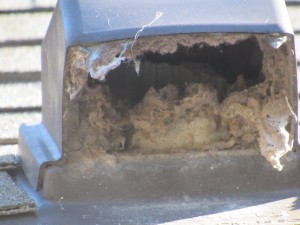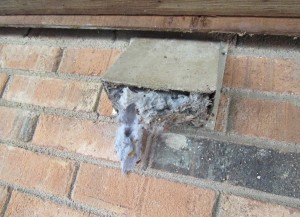Avoid Catching your Home on Fire- Dryer Safety
According the National Fire Protection Agency, Clothes Dryers and Washing Machines accounted for almost 17 thousand house fires in 2010. Those fires resulted in 51 deaths, 380 injuries and 236 million in property damage. The leading cause of these fires was failure to clean the appliance. Think about that. Taking just a few seconds to clean a lint trap and taking just a little bit of time to make sure your dryer damper is working could save your home from burning down. Perhaps even avoiding serious injury or death.
In this post you’ll learn about:
-Dangers of dryer lint
-Mold and fungal growth caused by exhuast terminating in crawl space or attic
-Checking your dryer duct
-Making sure your dryer damper opens and closes properly
Make sure you clean the dryer lint trap after every load. If this is neglected the excess lint is injected through the exhaust causing a blockage in the duct. I recently inspected a home where the dryer vent attached to the outside of the house was completely obstructed with lint. This is NOT good.
Why isn’t this good?
Clothes dryers work by evaporating the water from wet clothing by blowing warm air past them in the spinning drum. Depending on the size of the load, you could have more than a gallon of water that is turned into water vapor leaving through the exhaust. That’s why it’s very important to have the dryer exhaust exiting the home. If the duct or vent is obstructed, the hot air and moisture cannot exit the dryer which can lead to a fire. Lint is made up of small particles of clothing which when heated can act like tinder and spark a fire. Bottom line, inspection of the dryer ducts and preventative maintenance is very important to protect your family and home.
Additionally, I’ve inspected some homes that have the exhaust terminating either in the crawl space or attic. This can lead to elevated moisture levels in both these areas. This could lead to harmful mold and fungal growth.
Maybe you have a dryer ducts that stretch vertically to the roof? This may be beyond the ability of the average homeowner to reach or attempt to clean. If this is true for your situation, it may be better left to a professional who is certified and trained in cleaning ducts to inspect.
Lastly, this sounds redial but I’ll say it anyways. Your dryer damper is important to check. This is the door on the outer vent that opens when the dryer is on. And, when it’s blowing air it closes when its off. The closing part is important because that prevents unwanted pests from entering through the hole and setting up camp. A friend recently had dryer issues where the electric heating element repeatedly failed which caused them to call the appliance repair professional several times. After the third time, they determined that the dryer vent duct was completely obstructed by not only lint, but also a bird nest. The damper door was missing which created a nice hole for the bird to enter and set up camp.
Fortunately, this was an easy repair as the damper needed replacing and the duct needed cleaning. They were very fortunate and the obstruction didn’t cause a fire.
You should be cleaning the lint trap on the dryer after each load. Preform regular inspections of the dryer ducts and dampers to ensure that they are free from obstructions and that the damper door is working properly. Make sure that the dryer appliance is actually hooked up to a duct either in the back or bottom of the appliance and that the duct is vented to the outside.
What about you? Do you have other tips to share about dryer safety? I’d love to hear from you.





